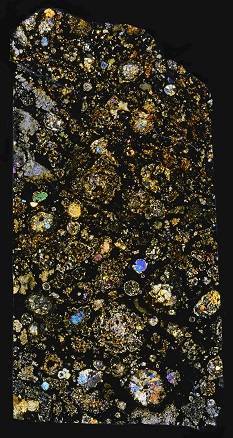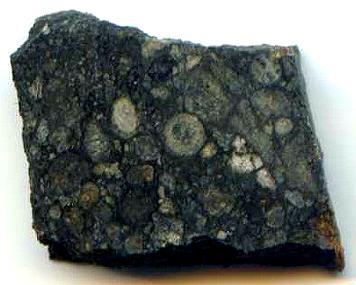Vigarano
CV3.3 (3.1–3.4)red
Fell January 22, 1910
44° 51′ N., 11° 24′ E. At 9:30 P.M. in the farming community of Vigarano Pieve, Italy, stones were seen and heard to fallMeteorite seen to fall. Such meteorites are usually collected soon after falling and are not affected by terrestrial weathering (Weathering = 0). Beginning in 2014 (date needs confirmation), the NomComm adopted the use of the terms "probable fall" and "confirmed fall" to provide better insight into the meteorite's history. If Click on Term to Read More. Two stones of 11.5 kg and 4.5 kg were found—the larger stone was recovered immediately, while the smaller stone was found a month later. This is the type specimen for the CV class, which has now been subdivided into four subgroups based on secondary mineralogy (McSween, 1977; Weisberg et al., 1997): reducedOxidation and reduction together are called redox (reduction and oxidation) and generally characterized by the transfer of electrons between chemical species, like molecules, atoms or ions, where one species undergoes oxidation, a loss of electrons, while another species undergoes reduction, a gain of electrons. This transfer of electrons between reactants Click on Term to Read More, oxidizedOxidation and reduction together are called redox (reduction and oxidation) and generally characterized by the transfer of electrons between chemical species, like molecules, atoms or ions, where one species undergoes oxidation, a loss of electrons, while another species undergoes reduction, a gain of electrons. This transfer of electrons between reactants Click on Term to Read More Allende, and oxidized Bali. The CV-oxidized and CV-reduced subgroups are separated on the basis of metalElement that readily forms cations and has metallic bonds; sometimes said to be similar to a cation in a cloud of electrons. The metals are one of the three groups of elements as distinguished by their ionization and bonding properties, along with the metalloids and nonmetals. A diagonal line drawn Click on Term to Read More abundances and the Ni content of sulfide (Howard et al., 2010). The previously used discriminator, magnetiteFe oxide, Fe2+Fe3+2O4, containing oxidized iron (Fe3+) found in the matrix of carbonaceous chondrites and as diagnostic component in CK chondrites. In CK chondrites, magnetite is typically chromian, containing several wt. % Cr2O3. Click on Term to Read More abundance, has been shown to overlap between oxidized and reduced subgroups. The oxidized-Bali subgroup has a higher degree of aqueous alteration than oxidized-Allende (for more mineralogical relationships, see Appendix I, Carbonaceous Chondrites). Other members of the reduced subgroup to which Vigarano belongs include Arch, Efremovka, and Leoville.
| Raman | TL | |
|---|---|---|
| Allende | >3.6 | 3.2 |
| Axtell | >3.6 | 3.0 |
| Grosnaja | ~3.6 | 3.3 |
| Mokoia | ~3.6 | 3.2 |
| Bali | >3.6 | 3.0 |
| Efremovka | 3.1–3.4 | 3.2 |
| Vigarano | 3.1–3.4 | 3.3 |
| Leoville | 3.1–3.4 | 3.0 |
| Kaba | 3.1 | 3.0 |
The differences that exist between these methods of subtype determination are explained by Greenwood et al. (2009) in their study of CV and CK chondriteClass of carbonaceous chondrite named for the Karoonda meteorite that fell in Australia in 1930. They are more oxidized than all other carbonaceous chondrites and genetically distinct from CV chondrites. CK chondrites appear dark-gray or black due to a high percentage of Cr-rich magnetite dispersed in a matrix of dark Click on Term to Read More relationships. They assert that there is a decoupling between the silicateThe most abundant group of minerals in Earth's crust, the structure of silicates are dominated by the silica tetrahedron, SiO44-, with metal ions occurring between tetrahedra). The mesodesmic bonds of the silicon tetrahedron allow extensive polymerization and silicates are classified according to the amount of linking that occurs between the and organic components with respect to measurements involving thermal metamorphism.
The reduced subgroup members are the least altered of the CV-group members. The oxidized subgroups have a range of characteristics which attest to a higher degree of thermal metamorphism than that experienced by the reduced subgroup. In a comparison between the inclusions in olivine grains in both reduced and oxidized CV3 subgroups, it was concluded by Abreu and Brearley (2011) that matrixFine grained primary and silicate-rich material in chondrites that surrounds chondrules, refractory inclusions (like CAIs), breccia clasts and other constituents. Click on Term to Read More olivines in the oxidized subgroup (Allende-like) could not have been derived through thermal processing of reduced (Vigarano-like) material. Still, it is generally presumed that all of the oxidized groups did derive from previously reduced material. Vigarano is a regolithMixture of unconsolidated rocky fragments, soil, dust and other fine granular particles blanketing the surface of a body lacking an atmosphere. Regolith is the product of "gardening" by repeated meteorite impacts, and thermal processes (such as repeated heating and cooling cycles). Click on Term to Read More brecciaWork in Progress ... A rock that is a mechanical mixture of different minerals and/or rock fragments (clasts). A breccia may also be distinguished by the origin of its clasts: (monomict breccia: monogenetic or monolithologic, and polymict breccia: polygenetic or polylithologic). The proportions of these fragments within the unbrecciated material Click on Term to Read More, shocked to stage S1–2, containing solar-wind gases and both reduced and oxidized components, including oxB clasts and chondrulesRoughly spherical aggregate of coarse crystals formed from the rapid cooling and solidification of a melt at ~1400 ° C. Large numbers of chondrules are found in all chondrites except for the CI group of carbonaceous chondrites. Chondrules are typically 0.5-2 mm in diameter and are usually composed of olivine Click on Term to Read More, and CAIsSub-millimeter to centimeter-sized amorphous objects found typically in carbonaceous chondrites and ranging in color from white to greyish white and even light pink. CAIs have occasionally been found in ordinary chondrites, such as the L3.00 chondrite, NWA 8276 (Sara Russell, 2016). CAIs are also known as refractory inclusions since they Click on Term to Read More of both oxB and oxA types. FayalitePure* iron end-member (Fe2SiO4) of the olivine solid solution series and an important mineral in meteorites. When iron (Fe) is completely substituted by magnesium, it yields the the pure Mg-olivine end-member, forsterite (Mg2SiO4). The various Fe and Mg substitutions between these two end-members are described based on their forsteritic (Fo) Click on Term to Read More grains have been identified in oxB clasts which were formed prior to brecciationThe formation of a breccia through a process by which rock fragments of of various types are recemented or fused together. Click on Term to Read More, during early aqueous alteration processes (Jogo et al., 2006). Application of Mn–Cr dating techniques to the fayalite grains indicate a formation time of 4.561 (±.001) b.y. ago, identical to that of other oxB members. Clasts have been identified in Vigarano which represent layered regolithic ponds composed of multiple layers (beds) that were developed through a seismically-driven, gravitational sorting/settling mechanism (Zolensky et al., 2013). Each bed is similarly composed of a band of iron-rich silicate having both a gradual (top) and an abrupt (bottom) transition into the other fine-grained mineralInorganic substance that is (1) naturally occurring (but does not have a biologic or man-made origin) and formed by physical (not biological) forces with a (2) defined chemical composition of limited variation, has a (3) distinctive set of of physical properties including being a solid, and has a (4) homogeneous Click on Term to Read More components making up the layer. Phyllosilicate-rich clasts and rims on many chondrules provide evidence of extensive aqueous alteration occurring on the Vigarano parent bodyThe body from which a meteorite or meteoroid was derived prior to its ejection. Some parent bodies were destroyed early in the formation of our Solar System, while others like the asteroid 4-Vesta and Mars are still observable today. Click on Term to Read More. Calcium carbonateMineral or compound containing carbon and oxygen (i.e. calcium carbonate, CaCO3, calcite). Click on Term to Read More of terrestrial origin occurs in veins throughout the meteoriteWork in progress. A solid natural object reaching a planet’s surface from interplanetary space. Solid portion of a meteoroid that survives its fall to Earth, or some other body. Meteorites are classified as stony meteorites, iron meteorites, and stony-iron meteorites. These groups are further divided according to their mineralogy and Click on Term to Read More, which was precipitated by aqueously-induced oxidationOxidation and reduction together are called redox (reduction and oxidation) and generally characterized by the transfer of electrons between chemical species, like molecules, atoms or ions, where one species undergoes oxidation, a loss of electrons, while another species undergoes reduction, a gain of electrons. This transfer of electrons between reactants Click on Term to Read More of metal and a consequent increase in pH. This secondary product is present in greater abundance in the smaller, later recovered stones (Abreu and Brearley, 2005). Notably, minor occurrences of pre-terrestrial carbonate have also been identified, which was formed through the extended process of augiteHigh-Ca clinopyroxene, (Ca,Mg,Fe)SiO3, that occurs in many igneous rocks, particularly those of basaltic composition. In order to be considered augite, the clinopyroxene must contain 20 to 45 mol % of calcium (Wo20 - 45). An important and unique Martian meteorite is NWA 8159, that has been classified as an augite basalt. Click on Term to Read More replacement by calcite. Metal and sulfide phases are present in relatively low concentrations (e.g., 50–100 ppmParts per million (106). Click on Term to Read More troiliteBrass colored non-magnetic mineral of iron sulfide, FeS, found in a variety of meteorites. Click on Term to Read More; A. Brearley, 2007). The three recognized CV3 subgroups reflect varying degrees of aqueous/oxidative alteration, which has been found to be correlated with the amount of ice-bearing matrix that was initially accreted (Ebel et al., 2009). Consistent with this, Fagan and Aoki (2015) reason that both the deformation of chondrules and the reduced modal abundance of matrix that is observed in the reduced subgroup compared to the oxidized subgroup is the result of an early impact event that reduced the porosityThe volume percentage of a rock that consists of void space. Vesicular porosity is a type of porosity resulting from the presence of vesicles, or gas bubbles, in igneous rock such as the pumice presented here. Vesicular porosity is very rare in meteorites and is often associated with slag, one Click on Term to Read More and voided the accreted ices, thus inhibiting fluid-assisted aqueous alteration. The shock pressure necessary to cause the observed deformation of chondrules was estimated to have been >20 GPa (Almeida et al., 2015). The matrix component in the reduced subgroup is significantly less than in the oxidized subgroup, only half as abundant in Vigarano than in Allende, and the former has a composition that is phyllosilicate-poor. Matrix material in Vigarano is present in two distinct forms: 1) a porous matrix that contains primordial noble gasesElement occurring in the right-most column of the periodic table; also called "inert" gases. In these gases, the outer electron shell is completely filled, making them very unreactive. Click on Term to Read More; and 2) a compact matrix that contains both primordial noble gases and low abundances of solar noble gases (Noguchi et al., 2003). Both the Vigarano matrix and the fine-grained rims surrounding chondrules and CAIs are compositionally very similar (Hammond et al., 2007). Moreover, this fine-grained material has a complementary composition to the chondrules, suggesting that all of these components formed within a common nebulaAn immense interstellar, diffuse cloud of gas and dust from which a central star and surrounding planets and planetesimals condense and accrete. The properties of nebulae vary enormously and depend on their composition as well as the environment in which they are situated. Emission nebula are powered by young, massive Click on Term to Read More region. It was inferred that the shock waveAbrupt perturbation in the temperature, pressure and density of a solid, liquid or gas, that propagates faster than the speed of sound. model of formation is most consistent with these observations. The original O-isotopic composition of Vigarano is thought to have been 16O-rich, later becoming 16O-poor through exchange with nebular gases. Dark inclusions in Vigarano have undergone hydrationReaction of a substance with water. Click on Term to Read More and dehydration processes, leading to a mass-dependent fractionationConcentration or separation of one mineral, element, or isotope from an initially homogeneous system. Fractionation can occur as a mass-dependent or mass-independent process. Click on Term to Read More manifest in a heavy-isotope (δ18O) enrichment (Clayton and Mayeda, 1999). Despite the reduced nature of Vigarano, this heavy-isotope enrichment is thought to have been produced in an oxidizingOxidation and reduction together are called redox (reduction and oxidation) and generally characterized by the transfer of electrons between chemical species, like molecules, atoms or ions, where one species undergoes oxidation, a loss of electrons, while another species undergoes reduction, a gain of electrons. This transfer of electrons between reactants Click on Term to Read More, low-temperature aqueous environment. An unusual fine-grained dark inclusionFragment of foreign (xeno-) material enclosed within the primary matrix of a rock or meteorite. Click on Term to Read More found in Vigarano shows characteristics of having been formed through sedimentary processes in a fluvial environment, which occurred prior to its incorporation in the Vigarano host. All members of the CV class contain high-temperature oxide and silicate minerals of calcium–aluminum–titanium composition (CAIs). Relict presolar SiC grains are present within Vigarano CAIs. Based on the presence in Vigarano of material from all CV subgroups showing different degrees of aqueous alteration and thermal metamorphism, it can be inferred that all CV material originated on a single, heterogeneously altered parent body mixed by regolith gardening. Evidence for a large differentiated CV planetary body has been accumulating over time (see the ‘The Breakup of Antaeus’). This hypothesis is also attested by the fact that CV chondritesMeteorite class named after the Vigarano meteorite that fell in Italy in 1910. They have abundant large, well-defined rimless (?) chondrules of magnesium-rich olivine (~0.7 mm diameter; 40-65 vol. %), often surrounded by iron sulfide. They also contain 7-20 vol. % CAIs. The often dark-gray matrix is dominated by Fe-rich Click on Term to Read More acquired a strong unidirectional natural remanent magnetization ~9 m.y. after CAISub-millimeter to centimeter-sized amorphous objects found typically in carbonaceous chondrites and ranging in color from white to greyish white and even light pink. CAIs have occasionally been found in ordinary chondrites, such as the L3.00 chondrite, NWA 8276 (Sara Russell, 2016). CAIs are also known as refractory inclusions since they Click on Term to Read More formation, reflecting the existence of an internal coreIn the context of planetary formation, the core is the central region of a large differentiated asteroid, planet or moon and made up of denser materials than the surrounding mantle and crust. For example, the cores of the Earth, the terrestrial planets and differentiated asteroids are rich in metallic iron-nickel. Click on Term to Read More dynamo (e.g., Weiss et al., 2010; Elkins-Tanton et al., 2011; Carporzen et al., 2010, 2011; Gattacceca et al., 2013, 2016). Employing multiple investigation techniques, Shah et al. (2017 [EPSL open access article]) investigated the paleointensity of 19 Vigarano chondrules and found values of 1.1–150 µT. The observed magnetic remanence is considered to have been acquired during brecciation events that occurred ~7 m.y. after initial parent body accretionAccumulation of smaller objects into progressively larger bodies in the solar nebula leading to the eventual formation of asteroids, planetesimals and planets. The earliest accretion of the smallest particles was due to Van der Waals and electromagnetic forces. Further accretion continued by relatively low-velocity collisions of smaller bodies in the Click on Term to Read More, with impact shock pressures reaching 10–20 GPa. Therefore, they reason that the original paleofield would have been ~40 µT, which is too high to be attributable to the solar windSupersonic flow of high-speed charged particles continuously blowing off a star (mostly e- and p+). When originating from stars other than the Sun, it is sometimes called a "stellar" wind. The solar wind may be viewed as an extension of the corona into interplanetary space. The solar wind emanates radially field, but is in the range of that expected for a planetary core dynamo. As research continues, further evidence could advance the hypothesis for the catastrophic disruption of a large planetary-sized body. The specimen of Vigarano shown above is a 0.8 g partial slice, and the bottom image is an excellent petrographic thin sectionThin slice or rock, usually 30 µm thick. Thin sections are used to study rocks with a petrographic microscope. micrograph of Vigarano, shown courtesy of Peter Marmet.
click on image for a magnified view
Photo courtesy of Peter Marmet







